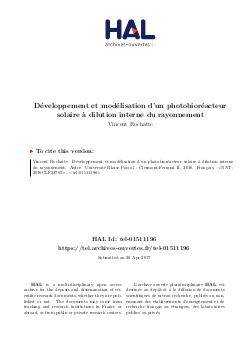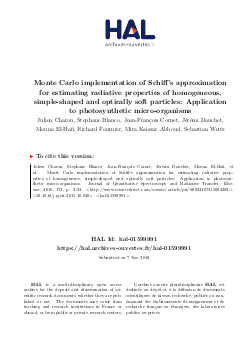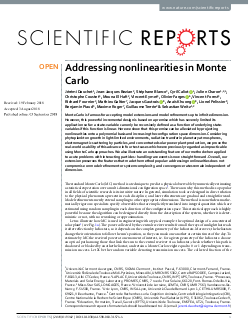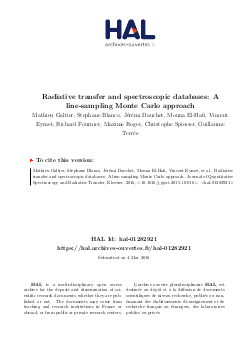Ingénierie des systèmes photoréactifs
Ces travaux de recherche concernent essentiellement les procédés utilisant la lumière visible solaire (ou artificielle) pour produire des molécules d’intérêt (biomasse, carburants comme H2, gaz de synthèse, méthanol, molécules à haute valeur ajoutée) ou régénérer l’atmosphère de systèmes clos (consommation de CO2 et production de O2).
La compréhension fine des procédés que sont les photobioréacteurs, photoréacteurs et cellules photo-électrochimiques est privilégiée, en vue de simuler, concevoir et optimiser des unités à terme industrielles possédant une efficacité énergétique et des performances cinétiques élevées, compatible avec les besoins futurs en énergie renouvelable solaire ou en molécules plateforme.
Pour cela, nous développons (et validons à l’échelle laboratoire ou pilote) des modèles de connaissance prédictifs multi-échelles et réifiés basés sur une complexité phénoménologique incluant (Cornet 2007; Dauchet et al. 2015; Dauchet 2012; Cornet, Dussap, and Dubertret 1992; Pilon, Berberoğlu, and Kandilian 2011; Pottier et al. 2005) :
- la prédiction ou la détermination des propriétés optiques (indices de réfraction / permittivité) des catalyseurs ou microalgues (DFT, Kramers-Krönig) ;
- le calcul des propriétés radiatives qui en découlent (équations de Maxwell) ;
- la résolution du transport de photons ou de charges (équations de Boltzmann) ;
- la formulation locale du couplage thermocinétique (approches mécanistiques ou basées sur la thermodynamique linéaire des processus irréversibles) ;
- l’intégration à l’échelle du procédé (module et centrale) et le calcul des efficacités cinétiques et thermodynamiques ;
- la prise en compte des fluctuations solaires dynamiques.
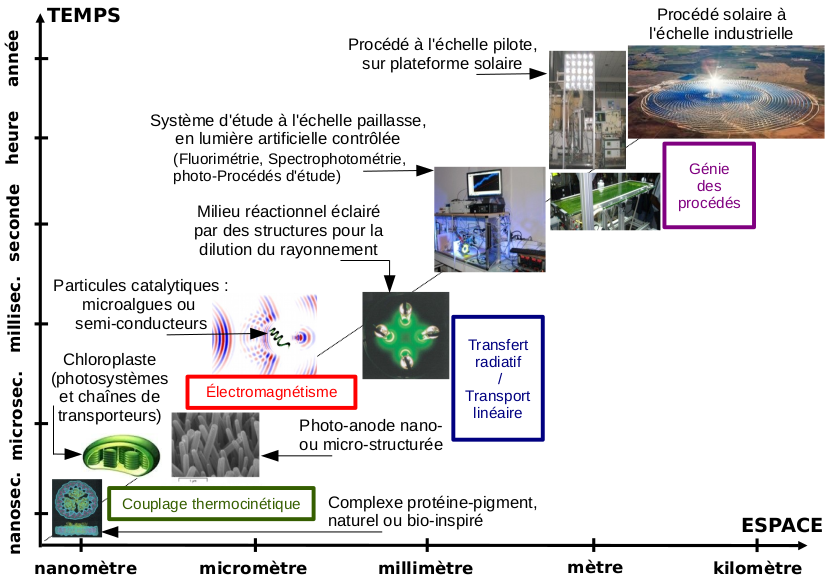
Une réflexion sur la formulation en intégrale de chemin de ces modèles et leur résolution par la méthode de Monte Carlo est menée dans le cadre de la plateforme EDStar. Cette approche permet une gestion unique de l’imbrication des phénoménologies aux différentes échelles et de la complexité géométrique (Gattepaille, n.d.; Dauchet 2012). Mais pour en bénéficier, les avancés les plus récentes pour le traitement des nonlinéarités avec la méthode de Monte Carlo sont nécessaires (Dauchet et al. 2018; Galtier et al. 2016). De plus, en amont, cette approche implique de disposer d’une formulation en espace de chemin pour chaque phénomène impliqué. Cela motive une recherche centrée sur la formulation intégrale des équations de Maxwell et ses approximations, ainsi que leur résolution par Monte Carlo (Charon et al. 2016; Charon, n.d.; Dauchet 2012).
Validée expérimentalement à petite échelle au moyen de dispositifs fortement instrumentés, cette méthodologie est appliquée avec enrichissement mutuel à l’ingénierie de la photosynthèse naturelle et artificielle (Supplis et al. 2018; Supplis, n.d.; Dahi 2016). Les pilotes originaux développés à ce jour (échelle de 1 L à 30 L ; jusqu’à 1 m2 de surface de captation) et conçus à partir des modèles couplés à des méthodes d’optimisation (théorie constructale, minimisation de la production d’entropie, analyse de sensibilités,…) laissent entrevoir à terme des efficacités thermodynamiques entre 10 et 30% pour la production solaire de vecteurs énergétiques stockables (Cornet 2010; Rochatte 2016).
Production de carburants solaires par cycle thermochimique
Des procédés solaires permettant la mise en œuvre de cycles thermochimiques à haute température, à base d’oxydes métalliques, sont aujourd’hui envisagés comme alternatives aux procédés pétroliers pour la production d’hydrogène. La conception et l’optimisation de ces dispositifs demande une évaluation fiable de la dynamique de conversion en lien avec les fluctuations de l’ensoleillement. Comme la conversion thermochimique répond non-linéairement aux variations de l’intensité du rayonnement collecté par le système de concentration, il est nécessaire de tenir compte précisément des fluctuations de petite échelle temporelle, même lorsque la question posée est celle du rendement intégré sur la durée de vie du dispositif.
Nous travaillons à la construction d’espaces de chemins permettant de simuler conjointement le concentrateur (un nombre élevé d’héliostat comme dans nos études sur les centrales solaires) et la conversion thermochimique, de façon contourner les difficultés rencontrées par les approches déterministes dans la gestion des échelles temporelles.
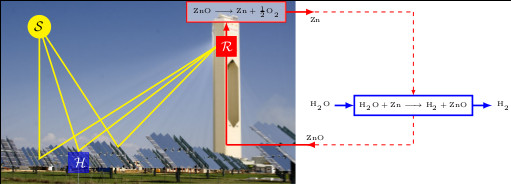
Références

